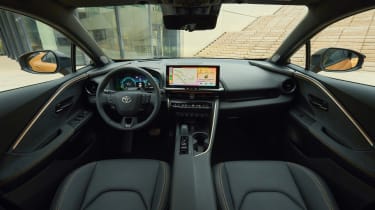New Toyota C-HR Plug-in review: fleet-friendly plug-in hybrid
Toyota’s C-HR gets a plug to boost efficiency and lower costs but it’s a better company car than it is a private one.
Verdict
It’s perhaps no surprise that Toyota is playing hardball already on finance with the C-HR PHEV, because for all its technical competence, refinement and real-world efficiency, this is a car that risks looking a bit expensive for its size and practicality. It makes lots of sense as a company-car choice, admittedly, assuming you’re not ready to go pure electric and save even more cash. But if Toyota really does want this car to tempt private buyers further along the path to electrification, it’ll need to stick to those keen interest rates.
Toyota does sell a pure-electric vehicle, the Toyota bZ4X, but for now at least, the company remains sharply focused on ‘transitional’ models that offer greater efficiency, while still using a petrol engine. It’s a policy that has brought the Japanese brand huge sales through its Yaris, Corolla and C-HR – and now there’s an additional level of electrification being offered on a third of those cars.
The C-HR is, of course, already available with a choice of 1.8-litre or 2.0-litre hybrid powertrains, cheekily referred to by Toyota as ‘self-charging’. But now there’s a plug-in hybrid version of the funky crossover too, promising more power and greater performance, mixed with improved efficiency and the sort of pure-electric range that brings considerable benefits to company-car tax payers.
The new set-up is based around the 2.0-litre hybrid model, but with a 13.6kWh battery instead of the tiny 2.4kWh unit in the regular cars. As a result, Toyota claims you can travel up to 41 miles on electric power alone, slotting the C-HR Plug-in (the official title) neatly into the eight-per cent band for Benefit-in-Kind company-car tax and making it a proper rival for the likes of the Kia Niro Plug-in Hybrid (also eight per cent) and the Cupra Formentor e-Hybrid (only 36 miles, so 12 per cent).
Used - available now

2021 Kia
Sportage
25,130 milesManualDiesel1.6L
Cash £16,491
2021 Vauxhall
Mokka
27,385 milesAutomaticPetrol1.2L
Cash £17,308
2019 Mazda
3
39,913 milesManualPetrol2.0L
Cash £16,995
2022 Mazda
3
19,634 milesManualPetrol2.0L
Cash £17,995Predictably, the C-HR PHEV also aces the WLTP tests so the official efficiency figures are miles beyond what the regular 2.0 hybrid can achieve: 353mpg instead of 57mpg, 19g/km of CO2 emissions instead of 110g/km. Performance improves too, with a 0-62mph time of 7.4 seconds that’s not far off a whole second quicker than the non-plug-in 2.0, and around three seconds clear of the regular 1.8.
Toyota argues that having the fifth-generation hybrid system at the heart of the vehicle makes the C-HR PHEV a better real-world bet than many of its rivals, because when it’s not running on pure-electric power, it’s still a pretty frugal set-up. It won’t quite deliver the usual efficiency, though, because it’s lugging around a much larger battery pack (the overall penalty is around 200kg) – so regular hook-ups to a power connection will still be key. The charger operates at 6.6kW AC, allowing a full refill from empty at a home wallbox in around two and a half hours, but there’s no DC option for quicker top-ups.
Toyota is positioning the PHEV in the upper band of the C-HR range, so there’s no entry-level Icon model like with the regular hybrids. Instead the line-up starts with Design, at £39,145, and this has a pretty decent list of standard kit. You get 18-inch alloys, a powered tailgate, heated front seats, dual-zone air conditioning, a pair of 12.3-inch dashboard screens (one for instruments, the other for infotainment) and a wireless smartphone charger.
Step up to Excel (£42,610) and you’ll get a bi-tone exterior paint job, 19-inch alloys, front sports seats, a panoramic roof and extra safety tech, while range-topping GR Sport (£43,540) focuses on sporty looks with styling add-ons and 20-inch alloys. It also gets an upgraded JBL audio system as standard, but to access some of the features from Excel, such as the panoramic roof, you’ll need to dip into the options packs.
Today we’re driving a European equivalent of Excel – and the good news is that the driving experience feels pretty similar to the regular C-HR’s. You can feel that there’s a little more mass involved, although the reprofiled suspension does a good job of soothing out a lot of road imperfections. Body control, meanwhile, remains crisp, and there’s enjoyment to be had in using this, and the meaty, direct steering, to keep the C-HR up to speed along a fast, flowing road.
Trying to hustle the car along twistier routes exposes the usual Toyota hybrid flaw, as the CVT transmission sends the revs rising. This is less of an issue than ever, thanks to the level of electrical assistance that’s now available, but it’s still fair to say that despite the extra performance on offer here, the chassis is far more up for involvement than the powertrain.
Still, at a cruise the C-HR is commendably refined, with the engine but a distant thrum and some hard work on acoustics paying off to reduce the amount of road noise that finds its way through to the cabin.
The C-HR PHEV has a selection of operating modes. By default it runs in ‘EV’ – so if you get in and just press the on button, it’ll run through every scrap of charge it can until it has no choice but to fire up the engine. You can also flick it into ‘HV’ mode, which will maintain the level of charge in the PHEV battery until you’re ready to go pure electric, or pick an ‘Auto EV/HV’ setting that flicks between the two intelligently, using everything from driving style to navigation and elevation data.
Finally, there’s ‘charging mode’, activated by holding down a button and dependent on the amount of charge left in the battery. If it’s depleted enough, this setting runs the petrol engine more than it would otherwise need to, and uses the surplus electricity generated by it to replenish the battery reserves. You’d use this on a longer journey that’s going to end in a built-up area, for example, and on our short test run it did seem to add a few percent to the battery meter in only a few minutes – although, of course, it’s not as efficient a way of recharging as just plugging the car into a wallbox.
Even with this arsenal of settings, the Toyota C-HR Plug-in is still a car that feels most comfortable around town. Regardless of whether you’re forcing it to run in EV mode or allowing the car to judge for itself, it’s great at squirting neatly out of junctions and through traffic – helped again by a sophisticated suspension set-up (MacPherson struts at the front, double wishbones the rear) that protects the car’s occupants from being unsettled by manhole and drain covers. Even in ‘Auto EV/HV model’, it seems every bit as keen as the regular hybrid to spend around 70 per cent of its time running on electricity. And as we’ve come to expect from Toyota’s hybrid tech, the transitions between power sources – when they’re required – are extremely smooth. You can also play with the levels of brake energy recuperation to deliver something approaching a single-pedal experience.
Inside, there’s little to tell you that you’re in a PHEV instead of a regular hybrid, beyond a couple of extra buttons on the dashboard for those modes. That means you get a neatly finished cabin, with squidgy plastics in most of the right places and an impressively large and quick infotainment screen – albeit with a slightly fussy, hard-to-follow navigation system. It also remains gloomy and a little cramped for those in the rear seats; the Excel’s panoramic roof (which is also coated to keep the car cooler in summer, warmer in winter) is needed to lift the mood.
Sadly, the larger battery of the PHEV does mean a loss of some boot capacity – and this compared with the regular 2.0 model, which is itself less practical then the 1.8 (the larger engine forces the 12V battery to be positioned beneath the boot floor). So the PHEV’s loadbay measures just 310 litres; that’s around 50 litres down on the 2.0 hybrid’s, and nearly 80 litres less than the 1.8’s. It’s actually a pretty poor figure for a car of this size; as an example, a top supermini like the Renault Clio manages 391 litres, and both the Niro and Formentor have more boot space in plug-in form. More than ever, practicality is not this C-HR’s star turn.
Still, Toyota is going quite punchy on pricing with the C-HR Plug-in, which it expects to account for up to a fifth of all C-HR sales in the UK. It has already attached a keen interest rate to finance deals on the new arrival, in fact (1.9 per cent APR at the time of writing), which brings monthly PCP rates on a Design PHEV down to £516, based on a £4,000 deposit and a three-year/30,000-mile contract. That’s over £100 per month cheaper than Kia’s current Niro offer, and also less than what Cupra will charge you for a Formentor e-Hybrid.
| Model: | Toyota C-HR Plug-in Excel |
| Price: | £42,610 |
| Powertrain: | 2.0-litre 4cyl petrol, 1x e-motor, 13.6kWh battery |
| Transmission: | CVT auto, front-wheel drive |
| Power: | 220bhp |
| 0-62mph: | 7.4s |
| Top speed: | 112mph |
| Range: | 41 miles |
| Economy/CO2: | 353mpg/19g/km |
| Dimensions (l/w/h): | 4,362/1,832/1,564mm |
| Fuel tank | 43-litre |
| On sale: | Now |











